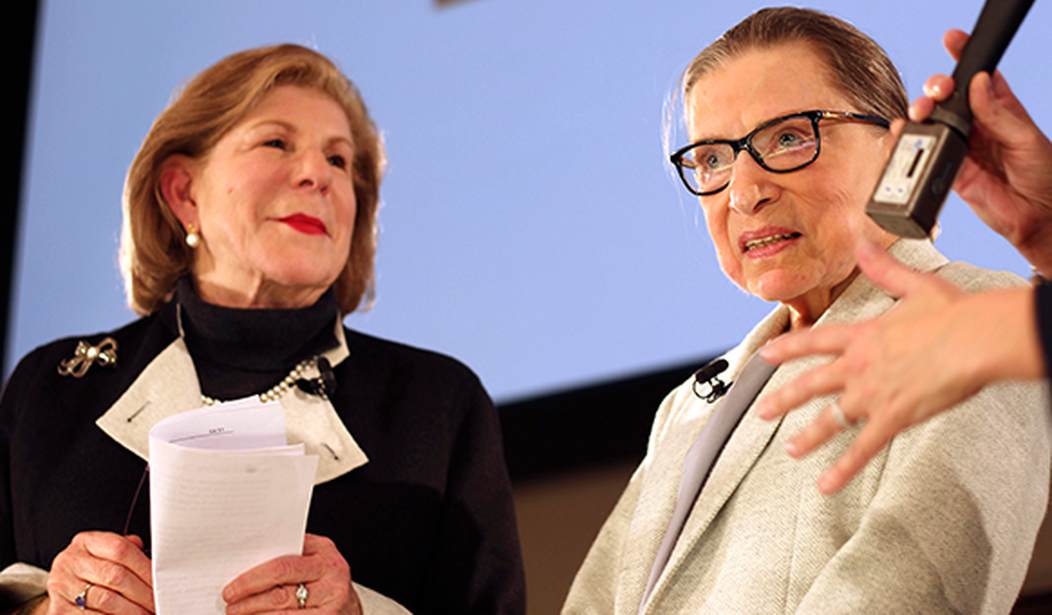My headline probably overstates author Michael Schaeffer’s conclusion a bit, but there are reasons for his which we’ll get to in a moment. First of all, he deserves some credit for at least raising the point that Nina Totenberg’s new book about her friendship with the late Ruth Bader Ginsburg raises some red flags about a host of issues, starting with Totenberg’s decision to sit on one of the biggest stories of her career.
It was 2020, an election was looming, and RBG was dying. During lockdown, we learn in the book, Totenberg’s home was the one place Ginsburg went other than her own apartment. Their weekly Saturday suppers made Totenberg one of the few Americans to lay eyes on the justice during the months of isolation. By July, Ginsburg could not climb the six steps into the house without a bodyguard holding her around the waist. At her apartment, she fell asleep midmeal, a fork still in her hand. She wore clothes meant to disguise how much weight she’d lost. Her gloves — which had become a fashion statement — were actually there to cover the IV wounds on her hands…
“In the beginning, I had conned myself into thinking that there was every reason to believe Ruth would survive this. But as the months rolled on, it became clear that this illness wasn’t just lung cancer. It was a return of the old pancreatic cancer,” one of the deadliest forms of the disease.
Totenberg sort of denies she really knew or that she sat on the story but like Schaeffer I don’t completely buy it. Any other reporter who had a front row seat to Ginsburg’s decline could have figured it out.
Schaeffer goes on to question the whole idea of chummy, Washington, DC access journalism. He implies that the kind of relationship Totenberg had with Ginsburg and many of the court’s other justices necessarily means she was not acting as a truly objective reporter.
Totenberg became part of the RBG hype machine. As the justice became an unlikely celebrity, she and Totenberg developed a sort of stage act, conducting public interviews before ticketed audiences. Totenberg would share questions in advance. The responses were more thoughtful that way, which it seems was really what the evenings were trying to show…
I’m not saying Totenberg has to treat the justices as if they were venal, low-wattage members of the Palookaville ward-politics machine. But it’d be nice if she held open the possibility — a hard thing to do when you’re pals…
If Totenberg were an architect or a history professor or an airline pilot or an actuary, the emotional blind spots would be her business. But she’s a reporter, a very influential one. Which means that those of us who have relied on her reporting but didn’t experience the heartwarming calls or the gossip-filled evenings are within our rights to apply a certain selfish cost-benefit analysis: What exactly do we get out of her friendships? Totenberg says that intimacy with justices and public officials made her a more thoughtful reporter and a better person. I’ll buy it. Yet even if you don’t think any amount of scary Ginsburg-health reporting could have deterred Mitch McConnell in 2020, it’s hard to come away from this book and not think the bonds also cost her something — and us, too.
I’m with him to a point. I don’t have any problem with lawmakers and staffers forming friendships across the aisle. That seems healthy but I do wonder if reporters don’t have a professional responsibility to either present their stories straight, regardless of those friendships, or openly admit the friendships matter more to them than their job.
Totenberg has effectively done the latter at the end of her long career by publishing the book, but Schaeffer is right that this is probably something readers had a right to know about her long before now. But there’s a glaring problem with Schaeffer’s own story. The whole thing is framed as a criticism of Totenberg’s journalistic approach but the story is also rife with the kind of blatantly partisanship that journalistic ethics were intended to avoid.
Notice that line above about deterring Mitch McConnell. Schaeffer spins out a whole theory about how a more blunt approach by Totenberg might have prevented the overturning of Roe v Wade.
…there’s a chance that a blunt story about Ginsburg’s decline might have changed the trajectory that led to the end of Americans’ right to abortion. As competitors’ sensationalist stories focused on Ginsburg’s health, activists might have gotten GOP senators (many of them locked in tight elections) on the record promising to not fill the seat until after the voters had a say in the November presidential election. The lurid coverage would surely have undercut the element of surprise that enabled Mitch McConnell to move almost immediately to muscle through a replacement.
It never seems to occur to Schaeffer that just as it wasn’t Totenberg’s job to be Ginsburg’s bestie it also wasn’t her job to sway the outcome of future court decisions. In other words, there was a noble case to be made for betraying Ginsburg’s trust about her condition (to be a real reporter and share the truth with people) and then there’s a not so noble case for doing so (to stick it to Mitch McConnell). Schaeffer seems to want Totenberg to veer from journalistic error but for entirely the wrong reasons.
Again, I think he has a point about Totenberg not being much of a journalist to the degree she acted as Ginsburg’s buddy rather than a reporter. But if that’s a problem it’s a problem because it leads to decades of juiced coverage favoring your friends, not because in this one instance it may have benefitted your opponents.









Join the conversation as a VIP Member